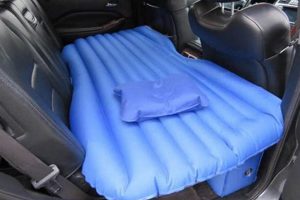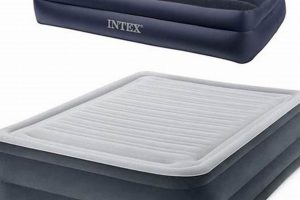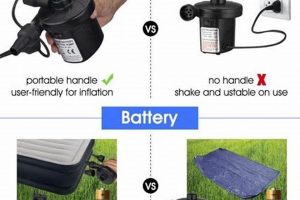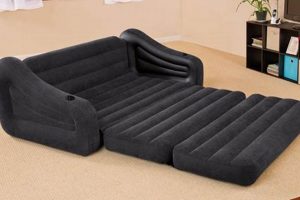Addressing breaches in inflatable sleeping surfaces involves identifying the source of escaping air and then applying a sealant or patch to restore airtight integrity. This process typically requires locating the puncture, preparing the surrounding surface, and utilizing an appropriate adhesive or patching material. Success ensures the continued functionality of the inflatable bed.
Maintaining the integrity of air-filled sleeping solutions offers several advantages, including cost savings by avoiding replacement, environmental benefits through reduced waste, and ensuring a comfortable and supportive sleep surface. Historically, methods for repairing such items have evolved from simple adhesives to specialized repair kits designed for durability and ease of application.
The following sections will detail the necessary materials, methods for leak detection, preparation techniques, and application processes involved in effectively restoring an air mattress to its intended condition, promoting its longevity and usability.
Essential Strategies for Air Mattress Leak Repair
The subsequent guidelines outline critical steps to ensure successful and lasting repairs to inflatable mattresses, mitigating air loss and extending product lifespan.
Tip 1: Conduct a Thorough Inspection: Before commencing any repair, meticulously examine the entire surface. Pay close attention to seams and areas subject to stress, such as those around valves. A comprehensive evaluation minimizes the risk of overlooking multiple leaks.
Tip 2: Employ Soapy Water for Leak Detection: Applying a mixture of soap and water to the inflated mattress and observing for the formation of bubbles is a reliable method for pinpointing leaks, particularly those that are minute and difficult to detect visually.
Tip 3: Clean the Repair Area: Prior to applying any adhesive or patch, thoroughly clean the area surrounding the leak with isopropyl alcohol. This removes dirt, oils, and other contaminants, promoting optimal adhesion and a durable bond.
Tip 4: Use a Suitable Patching Material: Utilize a patch specifically designed for vinyl or PVC, depending on the mattress material. Generic patches may not adhere correctly or provide a long-lasting repair.
Tip 5: Apply Adhesive Sparingly and Evenly: When using adhesive, apply a thin, uniform layer to both the patch and the prepared surface on the mattress. Avoid excessive application, which can weaken the bond or cause adhesion failures.
Tip 6: Ensure Adequate Curing Time: Allow the adhesive to cure fully according to the manufacturer’s instructions before inflating the mattress. Premature inflation can compromise the repair and lead to recurrence of the leak.
Tip 7: Reinforce Large Tears: For substantial tears, consider using a larger patch or overlapping multiple patches to provide additional reinforcement and prevent further propagation of the damage.
Adhering to these strategies significantly increases the likelihood of a successful and durable repair, preserving the functionality and comfort of the air mattress.
The subsequent section will explore advanced techniques for addressing complex or persistent leaks and preventative measures to minimize future damage.
1. Identify Leak Source
Locating the precise origin of an air leak is the foundational step in any effective repair of an inflatable mattress. Failure to accurately identify the breach renders subsequent repair efforts futile. The principle follows a direct cause-and-effect relationship: the leak causes deflation, and identifying the leak’s location is necessary to apply a targeted solution. Identifying the leak source represents the first crucial component within the broader procedure of restoring the air mattress to functional condition. A real-life example might involve a slow leak near a seam; if the user only inspects the mattress’s surface, the actual point of failure remains undetected, leading to continued deflation despite attempted repairs.
Practical significance lies in optimizing resource use and repair efficiency. Instead of blindly applying patches across the mattress surface, identifying the specific point of air escape allows for a focused and minimal intervention. This is achieved via auditory detection (listening for hissing sounds), tactile examination (feeling for air currents), or visual inspection using soapy water to reveal bubble formation at the leak site. These methods provide actionable information, directing efforts to the problem area, which could be a puncture from a sharp object, seam separation due to stress, or valve malfunction.
In summary, accurate leak source identification is paramount for effective air mattress repair. It ensures targeted interventions, prevents unnecessary patching, and ultimately prolongs the mattress’s lifespan. The primary challenge lies in detecting minute or intermittent leaks, necessitating thorough inspection and the use of appropriate detection techniques. Successfully addressing this initial step is integrally linked to the overarching goal of restoring and maintaining the inflatable mattress’s functionality.
2. Surface Preparation Critical
The effectiveness of any repair to an inflatable mattress relies heavily on the preparation of the surface surrounding the leak. This step, often underestimated, is essential for achieving a durable and lasting seal, preventing recurring air loss.
- Removal of Contaminants
The presence of dirt, oils, and residues on the mattress surface inhibits proper adhesion of patching materials. Isopropyl alcohol or a specialized cleaner effectively removes these contaminants, creating a clean substrate for bonding. A real-life example is attempting to apply a patch to a surface coated in suntan lotion; the patch will likely fail to adhere properly, resulting in a compromised repair.
- Surface Abrasion
Lightly abrading the area around the leak with fine-grit sandpaper or a similar abrasive material creates a textured surface, increasing the surface area available for adhesive bonding. This mechanical keying enhances the strength of the bond between the patch and the mattress. For instance, a smooth vinyl surface provides minimal grip for adhesives; abrasion introduces microscopic irregularities that improve adhesion.
- Complete Drying
Moisture impedes proper adhesive curing and bond formation. After cleaning the surface, ensuring complete dryness is crucial. Allowing the area to air dry thoroughly, or using a clean, dry cloth to expedite the process, prevents moisture from interfering with the adhesive’s chemical bonding process. An example would be applying a patch to a damp surface, which could lead to bubbling, peeling, and premat
ure failure of the repair. - Defined Repair Area
Clearly defining the repair area with masking tape or a similar method ensures that adhesive is applied only to the intended surface, preventing unwanted bonding to surrounding areas and creating a neat, professional finish. This also helps in controlling the spread of the adhesive and ensures that the patch is centered correctly over the leak. A scenario where masking is omitted may result in excess adhesive adhering to unintended areas, making the repair appear unprofessional and potentially causing damage to the mattress surface.
These preparation steps, executed with precision and attention to detail, significantly contribute to the longevity and effectiveness of any repair. Properly preparing the surface enhances adhesive bonding, prevents recurring leaks, and ultimately extends the functional lifespan of the inflatable mattress. Overlooking these aspects diminishes the chances of a successful repair, potentially leading to additional expenses and inconvenience.
3. Appropriate Patch Material
The selection of appropriate patching material directly influences the success of any attempt to repair a leak in an inflatable mattress. The relationship is fundamentally causal: using an incompatible or inadequate patch significantly increases the probability of repair failure, leading to continued air loss and rendering the mattress unusable. This concept represents a critical component within the overall procedure for restoring the mattress to its intended airtight condition. For instance, employing a cloth-based patch on a PVC mattress offers minimal adhesion due to differing material properties and chemical compositions, ultimately resulting in a superficial and ineffective seal. In stark contrast, utilizing a patch specifically designed for PVC creates a strong, durable bond, effectively preventing air leakage.
The practical significance of understanding this connection lies in optimizing resource allocation and preventing unnecessary efforts. Opting for the correct patch type ensures compatibility with the mattress material, facilitating the formation of a reliable seal. Patch kits tailored to inflatable mattresses typically include materials such as vinyl, PVC, or TPU (thermoplastic polyurethane), each designed to adhere effectively to the corresponding mattress construction. Furthermore, these specialized patches often possess qualities such as flexibility, durability, and resistance to temperature fluctuations, all contributing to the longevity of the repair. A common application involves repairing a puncture in a vinyl air mattress using a vinyl patch and adhesive specifically formulated for vinyl materials. This combination creates a chemically compatible bond, maximizing the strength and lifespan of the repair.
In conclusion, selecting the correct patch material is paramount for achieving a lasting and effective air mattress repair. It mitigates the risk of recurring leaks, conserves resources by preventing repeated attempts, and ultimately extends the mattress’s service life. Challenges can arise when the mattress material is not readily identifiable, necessitating careful examination of product labels or manufacturer specifications. However, prioritizing the selection of a material-appropriate patch is an indispensable step in the broader context of leak repair, inextricably linked to the restoration of the inflatable mattress’s functionality.
4. Adhesive Application Technique
The manner in which adhesive is applied directly impacts the success and longevity of air mattress repairs. Improper application techniques invariably lead to compromised seals, resulting in recurring leaks and rendering the repair ineffective. The adhesive serves as the critical interface between the patch and the mattress, and its proper utilization is paramount.
- Clean Application Surfaces
Adhesive application must occur on thoroughly cleaned and dried surfaces. Contaminants such as dirt, oil, or moisture hinder the adhesive’s ability to form a strong bond. For example, applying adhesive to a surface covered in skin oils will result in poor adhesion and eventual patch detachment. Proper cleaning with isopropyl alcohol or a similar solvent is imperative.
- Thin and Even Distribution
The adhesive should be applied in a thin, uniform layer across both the patch and the prepared area on the air mattress. Excessive adhesive can create a weak bond, as it may not cure properly and can remain pliable, allowing for air leakage. Conversely, insufficient adhesive will result in incomplete coverage and inadequate adhesion. A practical example is using a small brush or applicator to ensure even distribution.
- Appropriate Tack Time
Most adhesives require a specific “tack time,” where the adhesive is allowed to partially dry before the patch is applied. This allows for increased bond strength by facilitating better interaction between the adhesive molecules and the mattress surface. Premature application can lead to a weak bond, while excessively delayed application may result in insufficient adhesion. The manufacturer’s instructions should be consulted for optimal tack time.
- Uniform Pressure Application
Once the patch is positioned, uniform pressure must be applied to ensure complete and even contact between the patch, the adhesive, and the air mattress surface. This eliminates air pockets and promotes maximum adhesion. Failure to apply adequate pressure can result in localized areas of poor contact, leading to air leakage. A roller or a smooth, hard object can be used to apply consistent pressure across the entire patch area.
In summary, proper adhesive application is not merely a supplemental step but rather an integral component of a successful air mattress repair. Adherence to best practices, including surface preparation, controlled adhesive distribution, attention to tack time, and uniform pressure application, is essential for achieving a lasting, airtight seal and extending the usable life of the air mattress.
5. Curing Time Adherence
Adherence to recommended curing times is a critical, often overlooked, element in the successful repair of air mattress leaks. The bond formed between the patch, adhesive, and mattress material requires a specific duration to achieve its maximum strength. Premature inflation of the mattress before the adhesive has fully cured introduces stress to the bond, disrupting the molecular linkages and significantly diminishing the repair’s durability. Consequently, the patch may peel away or develop new leak points, negating the entire repair effort. A real-world scenario involves applying a patch, inflating the mattress after only a few minutes, and discovering the patch detaches completely after only slight pressure. This exemplifies the direct consequence of inadequate curing time.
The practical significance of respecting curing times lies in maximizing resource efficiency and ensuring long-term functionality. By allowing the adhesive to fully cure, a robust, airtight seal is formed, minimizing the likelih
ood of future leaks and the need for repeated repairs. This also contributes to cost savings by preventing the premature replacement of the air mattress. Curing times can vary significantly depending on the type of adhesive used, with some requiring as little as a few hours while others necessitate 24 hours or more. Following the manufacturer’s instructions precisely is essential to ensure optimal bonding. For example, cyanoacrylate adhesives (super glue) generally cure faster than vinyl repair adhesives, but may not offer the same degree of flexibility. Using an appropriate clamp or weight to maintain constant pressure during the curing process can further enhance the bond strength, especially for larger tears.
In summary, neglecting curing time requirements represents a significant risk factor in air mattress leak repair. Proper curing ensures a strong, lasting bond between the patch and the mattress, preventing recurring leaks and extending the mattress’s lifespan. The challenge lies in exercising patience and resisting the temptation to expedite the repair process. Successful adherence to recommended curing times is inextricably linked to the overall effectiveness of the repair, transforming a potentially temporary solution into a durable and reliable fix.
6. Reinforcement for Tears
Addressing larger tears in inflatable mattresses necessitates reinforcement techniques that exceed the capabilities of a standard patch application. Reinforcement methods aim to distribute stress across a wider area, preventing propagation of the tear and ensuring a durable, airtight seal.
- Overlapping Patches
Applying multiple patches, overlapping each other, provides layered support to the damaged area. Each patch acts as a buffer, distributing the stress and preventing any single point from bearing the full load. For instance, if a tear is 5 cm long, three patches might be applied: one directly over the tear, and two larger patches overlapping the central one on either side. This configuration creates a staggered reinforcement system, minimizing the likelihood of stress concentrations.
- Fabric Backing
Adding a layer of durable fabric, such as canvas or heavy-duty nylon, to the inside of the mattress beneath the tear offers significant reinforcement. This fabric acts as a structural support, preventing the tear from widening under pressure. The fabric is adhered using a flexible, waterproof adhesive compatible with the mattress material. This technique is particularly suitable for reinforcing tears in high-stress areas, such as seams or edges.
- Stitching (When Applicable)
In some instances, particularly with fabric-based inflatable mattresses, stitching the tear before applying a patch can provide additional reinforcement. The stitching closes the tear and draws the edges together, reducing stress on the adhesive bond. It is crucial to use a strong, waterproof thread and a stitching pattern that evenly distributes tension. This method is not appropriate for PVC or vinyl mattresses, as stitching will create perforations that lead to air leakage.
- Specialized Repair Compounds
Certain repair compounds are designed to fill tears and provide a flexible, durable repair. These compounds typically consist of a resin and a hardener that, when mixed, create a strong, waterproof material. The compound is applied to the tear, allowed to cure fully, and then sanded smooth. This method is suitable for smaller tears or for filling gaps before applying a patch. It provides structural integrity and helps to prevent the tear from reopening under pressure.
These reinforcement techniques, when applied appropriately, significantly enhance the durability and longevity of repairs to larger tears in inflatable mattresses. Integrating these methods with standard patching procedures addresses the underlying structural weakness caused by the tear, ensuring a robust and airtight repair. Failure to adequately reinforce larger tears often results in repeated failures and ultimately necessitates mattress replacement.
Frequently Asked Questions
The following addresses common inquiries regarding the identification, repair, and prevention of leaks in inflatable mattresses. The information provided aims to offer clarity and guidance based on established best practices.
Question 1: Is it always necessary to patch a leak in an air mattress, or can smaller leaks be ignored?
Ignoring even minor leaks is not advisable. Over time, small leaks will invariably worsen, leading to a gradual reduction in the mattress’s firmness and ultimately compromising its functionality. Prompt repair, regardless of the leak’s size, is recommended to preserve the mattress’s structural integrity and ensure a comfortable sleeping surface.
Question 2: What are the most common causes of leaks in air mattresses?
Leaks typically arise from punctures caused by sharp objects, seam separation due to stress or wear, valve malfunctions, and degradation of the mattress material over time. Improper storage, excessive weight, and exposure to extreme temperatures can accelerate the occurrence of these issues.
Question 3: Can any type of adhesive be used to repair an air mattress leak?
No. Generic adhesives are often unsuitable for repairing inflatable mattresses due to their lack of flexibility, poor adhesion to vinyl or PVC, and susceptibility to water damage. Specialized adhesives designed for vinyl or PVC repair are required to ensure a durable and waterproof seal.
Question 4: How can one ensure that the patch is properly aligned over the leak?
Accurate patch alignment is crucial for a successful repair. Prior to removing the backing from the patch, position it over the leak and carefully mark its outline with a pen or marker. This provides a visual guide for precise placement during application. Ensuring the entire leak is covered within the marked boundary is essential.
Question 5: What is the recommended method for storing an air mattress to prevent future leaks?
Proper storage practices significantly reduce the risk of future leaks. Before storing the mattress, ensure it is thoroughly clean and dry. Deflate it completely, fold it loosely to avoid creases, and store it in a cool, dry place away from sharp objects and extreme temperatures. Using the original storage bag or a similar protective cover is recommended.
Question 6: Is it possible to repair a leak near the valve of an air mattress?
Repairing leaks near the valve can be challenging due to the complex construction of the valve assembly. In some cases, specialized valve repair kits may be available. However, if the valve itself is damaged or significantly compromised, replacement may be the only viable option. Careful inspection of the valve is necessary to determine the extent of the damage and the feasibility of repair.
Effective air mattress leak repair hinges on accurate identification, proper preparation, appropriate materials, and adherence to established techniques. Ignoring even minor leaks can lead to more significant problems over time, while employing the wrong materials or methods can compromise the repair’s effectiveness.
The subsequent section will delve into advanced repair techniques and preventative strategies to further extend the lifespan of inflatable mattresses.
Concluding Remarks
The preceding discussion has illuminated the essential steps inv
olved in how to fix a leak in an air mattress, from meticulous leak detection to appropriate patch application and crucial curing procedures. Emphasis has been placed on the significance of surface preparation, material compatibility, and reinforcement strategies for substantial tears. The presented information serves as a guide for restoring the functionality and extending the lifespan of inflatable mattresses.
Effective implementation of these techniques necessitates a commitment to detail and adherence to best practices. Prolonging the usability of existing resources through conscientious repair contributes to responsible consumption and minimizes environmental impact. Continued vigilance regarding potential leak sources and proactive maintenance remain paramount in preserving the integrity of inflatable sleeping solutions.







